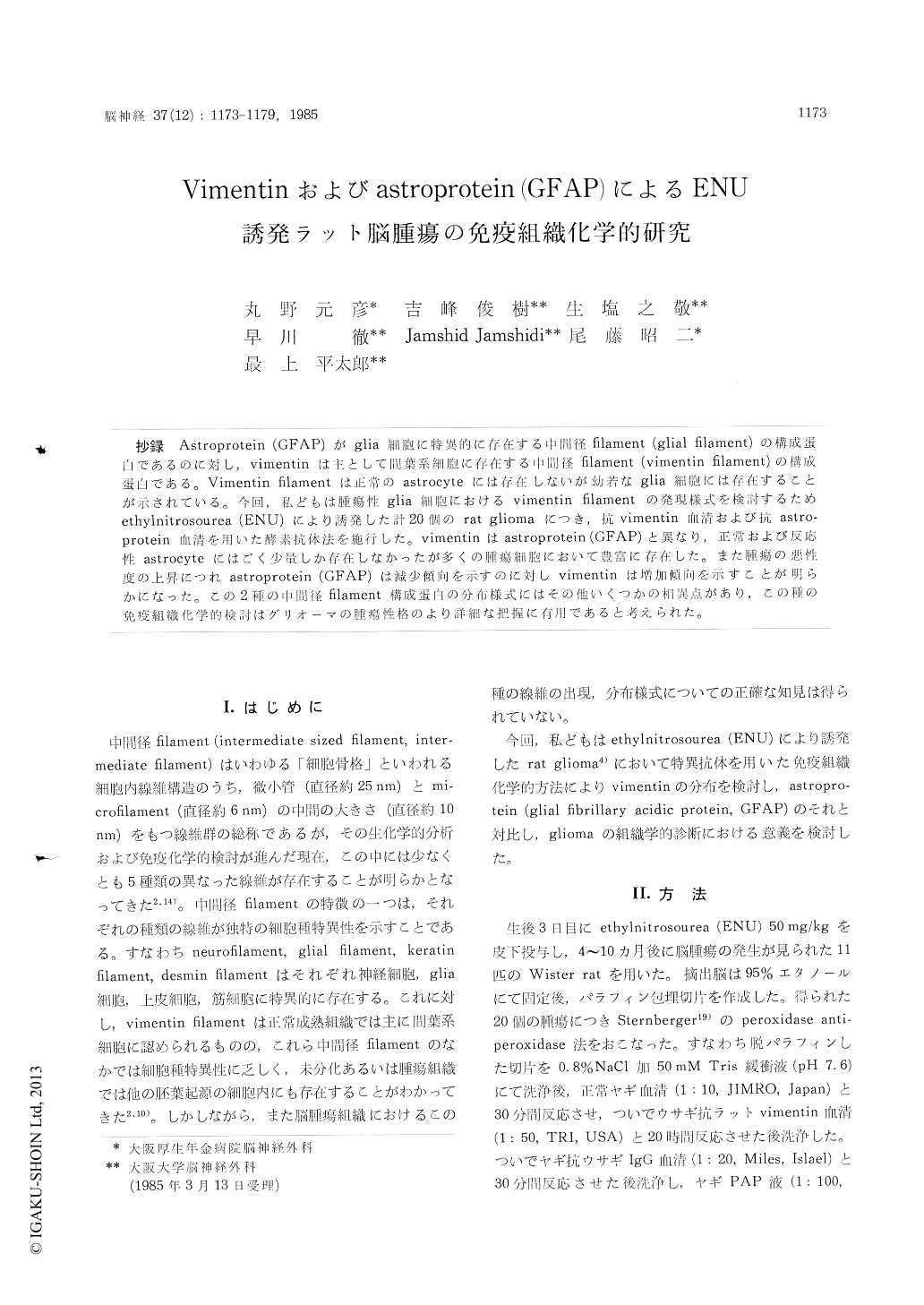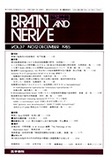Japanese
English
- 有料閲覧
- Abstract 文献概要
- 1ページ目 Look Inside
抄録 Astroprotein (GFAP)がglia細胞に特異的に存在する中間径filament (gliat filament)の構成蛋白であるのに対し,vimentinは主として間葉系細胞に存在する中間径filament (vimentin filarment)の構成蛋白である。Vimentin filamentは正常のastrocyteには存在しないが幼若なglia細胞には存在することが示されている。今回,私どもは腫瘍性glia細胞におけるvimentin filamentの発現様式を検討するためethylnitrosourea (ENU)により誘発した計20個のrat gliomaにつき,抗vimentin血清および抗astro—protein血清を用いた酵素抗体法を施行した。vimentinはastroprotein (GFAP)と異なり,正常および反応性astrocyteにはごく少量しか存在しなかったが多くの腫瘍細胞において豊富に存在した。また腫瘍の悪性度の上昇につれastroprotein (GFAP)は減少傾向を示すのに対しvimentinは増加傾向を示すことが明らかになった。この2種の中間径filament構成蛋白の分布様式にはその他いくつかの相異点があり,この種の免疫組織化学的検討はグリオーマの腫瘍性格のより詳細な把握に有用であると考えられた。
Expression of two different types of interme-diate filaments, vimentin filaments and glial fila-ments, was studied immunohistochemically in experimental rat gliomas. Although vimentin fila-ments are most commonly seen in mesenchymal cells, recent immunocytochemical study demonst-rated that this type of filaments can be recognized also in glial cells during early cell differentiation and in tumor cells of epithelial origin. In the present communication, distribution of vimentin filaments in rat glial tumors was investigated and compared with that of glial filaments by using specific antiserum to each protein subunit, vimen-tin and astroprotein (GFAP).
Ethylnitosourea (50 mg/kg) was injected subcu-taneouly into 3 day-old Wistar rats. After four to ten months, brains of animals were removed, fixed in 95% ethanol and embedded in paraffin. Peroxi-dase-antiperoxidase method was carried out on 6 micron-thick sections.
In normal portion of the brain, immunoreaction for vimentin was noted in ependymal cells and in vascular endothelial cells but not in astrocytes. This distribution contrasted with that of astro-protein (GFAP), which distributed in astrocytes but not in normal ependymal cells. These findingsconfirmed that the two antisera used in the present study do not crossreact to each other.
In contrast to the absence of vimentin immuno-reaction in normal astrocytes, a number of tumor cells showed positive reaction to the antiserum to vimentin. Mixed glioma with astrocytoma and oligodendroglioma had both astroprotein (GFAP)-positive and negative cells. Well developed cel-lular processes were noted in astroprotein (GFAP)-positive cells (astrocytoma cells). Weak immuno-reaction for vimentin was noted in those cells. In oligodendrogliomas, most tumor cells were negative for vimentin and astroprotein (GFAP), but a few number of cells reacted positively to both antisera. Those cells do not have appreciable cell processes and resembled oligodendroglia in shape. These immunocytochemical and morpho-logical properties suggested that those cells may represent a transitional form between oligodend-roglia and astrocyte. About a half number of tumor cells in anaplastic astrocytoma were positive for vimentin. The number of vimentin-positive cells were about the same as that of astroprotein (GFAP)-positive cells. The immunoreaction forvimentin in those cells was somewhat more intense than in benign astrocytoma cells. In glioblastomas, many tumor cells, large or small in size, were positive for vimentin and astroprotein (GFAP). The immunoreaction of small cells to anti-vimentin antiserum was stronger than that of large or giant cells.
In summary, the present study demonstrated that the expression of glial filaments in neoplastic astrocytes decreases as the tumors become malig-nant and that the immunoreaction for vimentin, which can be detected only weakly in benign astrocytoma cells, become strong in a selected group of cells in highly malignant tumors. Since vimentin filaments can not be recognized in nor-mal mature astrocytes, expression of this type of filaments may be related to the biological altera-tions of glial cells during neoplastic change. Most interestingly, strongest immunoreaction for vimen-tin was noted in a certain number of cells in tumors which showed most malignant histologic features.

Copyright © 1985, Igaku-Shoin Ltd. All rights reserved.


